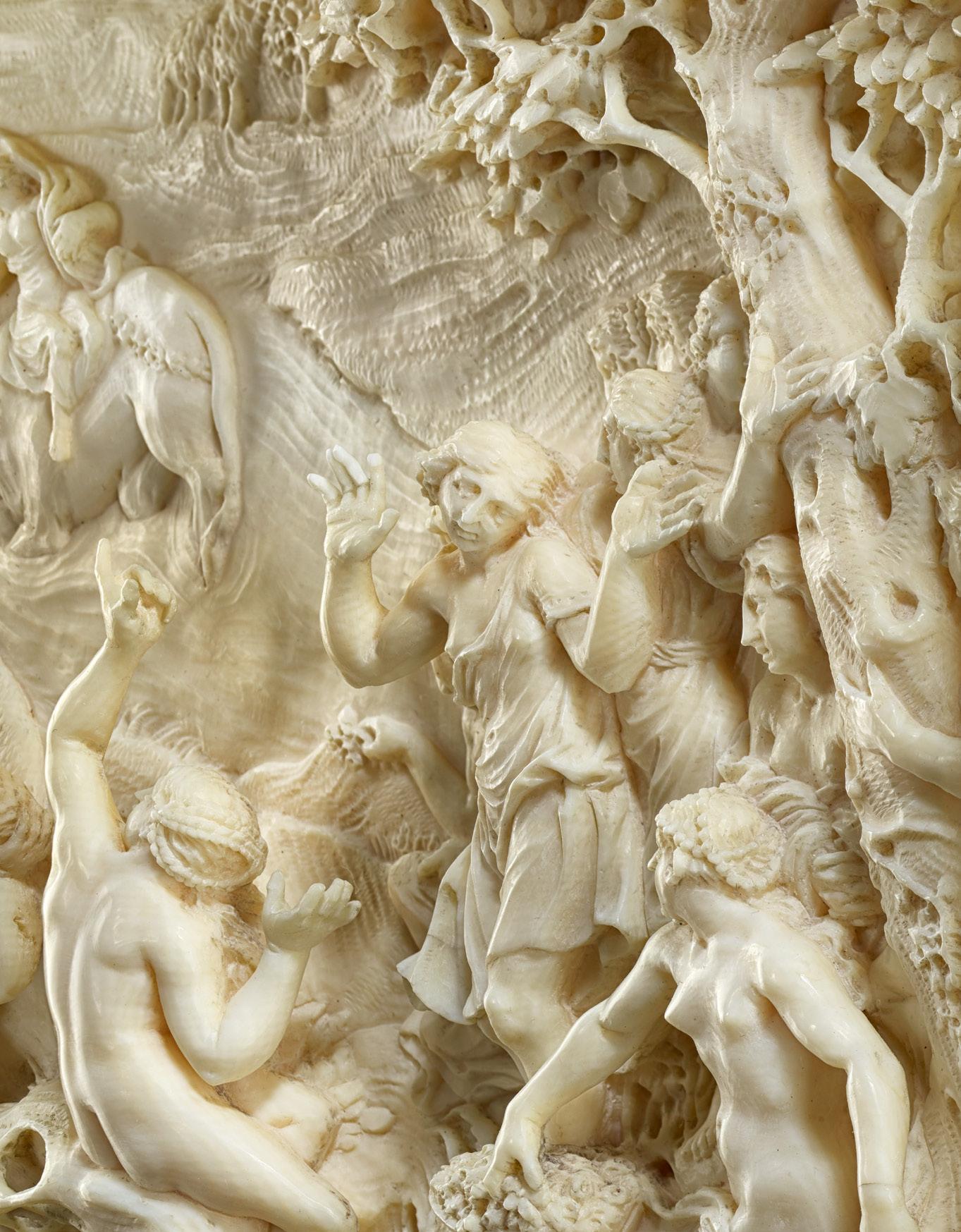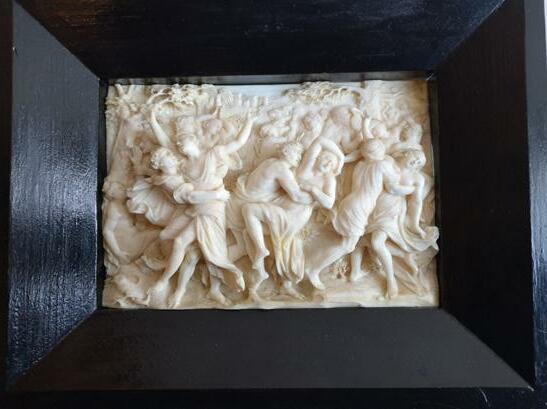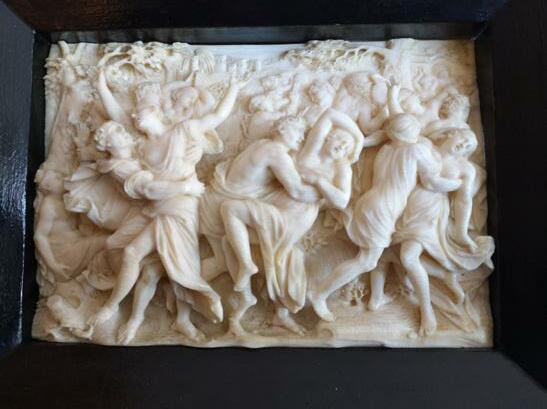
5 minute read
27 Relief of the Rape of Europa, by Dominikus Stainhardt
Relief of the Rape of Europa
27
Advertisement



Relief of the Rape of Europa
RELIEF OF THE RAPE OF EUROPA
Dominikus Stainhardt Weilheim 1655 – 1712 München
Last quarter of the 17th century Ivory Height: 8 cm, width: 17.4 cm, depth: 6.8 cm Europa was a Phoenician princess with whom Zeus fell in love. While playing with her companions on the beach of Sidon the god changed his appearance into that of a white bull and approached the maiden, laid down and let himself be stroked. After Europa had climbed, quite unsuspectingly, onto the bull’s back he ran off with her into the water and swam away. He reached the island of Crete where he revealed his true identity. She bore him three sons: Sarpedon, Minos, the later king of Crete, and Rhadamanthus, the judge of the dead.
Stainhart chose the dramatic moment of the abduction: Zeus, in the form of the mighty bull, carries the beautiful young princess over the stormy seas. Stainhart shows Europa’s distraught, gesticulating companions at the front of the composition in an extremely convincing manner.
The relief is characterised by the composition of its pictorial narrative. The dynamic, animated figures in the foreground are carved virtually in the round. By contrast, the execution of the middle ground, with the depiction of Europa and the bull, as well as the background, is almost flat. These compositional features are typical of the ivory carver Dominikus Stainhart (1655 – 1712) who signed the relief, below right, with his monogram ‘DS’.
The faces with straight noses, the hairstyles with plaits and ribbons, the draping of the garments and the furrows in the surface of the tree and water all point to the style of the sculptor from Weilheim.
27

Dominikus Stainhart, Raub der Sabinerinnen, Stiftssammlungen von St. Florian bei Linz, Inv. Pl65, 11,5 x 16,8 cm
Dominikus Stainhart (1655 – 1712) came from a family of carvers from Upper Bavaria. From 1674 until 1682 he travelled around Italy with his brother, Franz (1651 – 1695). Evidence exists that he was in Rome from 1678 until 1680 where he worked for the princely families of Colonna and Radziwill. A display cabinet that Dominikus decorated with ivory reliefs can still be seen in the Palazzo Colonna. It comprises a large, arched relief with a sculpted depiction of Michelangelo’s ‘Last Judgment’ and twenty-seven, small-format reliefs showing scenes from the Old and the New Testament. The overall composition for the display cabinet was designed by the architect Carlo Fontana who presumably specified the reliefs to be selected.
In 1682 the brothers returned home to Weilheim. In early 1683 Dominikus sought a position at the Bavarian Court in Munich but without success. At the beginning of that century, another sculptor from Weilheim, Christof Angermair, had been given the post as Ivory Sculptor to the Court. He created the famous coin cabinet for Maximilian I of Bavaria around 1625. Dominikus nevertheless moved to Munich in 1690 where he hoped to acquire more commissions. And, as it happened, he sold a series of six reliefs depicting tales from the Book of Moses to the Elector of Bavaria, Max Emanuel. Some of those are now in the Bayerisches Nationalmuseum/Munich. Several other works by Stainhart are also housed there, including four reliefs with his monogram ‘DS’ or his signature ‘D. Stainhart’: The Rape of the Sabine Women, Diana and her Nymphs Surprised by Satyrs, Venus and the Dead Adonis, Apollo Slaying Coronis, and Apollo and Daphne – all originally from the ‘Stroganov Collection, Leningrad’ that was acquired by the Bayerisches Nationalmuseum in 1931.
Apart from the reliefs in Munich and the one presented here, no other works are signed or have a monogram. The attribution of the majority of works to Stainhart is based on stylistic criteria.
It would seem that Dominikus Stainhart was successful in selling works from his workshop in Munich. Unfortunately, little archival material has been found to date that documents his activities and sales. Only in 1705 is he mentioned by name as being on the committee of the Guild of Sculptors in Munich. This not only suggests that he was a member but also testifies to his standing as a sculptor.

The model for a garden figure was most probably once painted. 3 It is similar to an allegory of summer that Tietz made in 1765/67 for the court garden at Veitshöchheim in which the motif of the kneeling peasant woman with a gift of grain also appears. The small putto, however, is not included and the goddess is clothed. The virtuosity and dynamism of the small sculpted work are lacking; instead the garden figure exudes a calm majesty. In the case of the garden figure Tietz also eschewed the sensually erotic aesthetic and gleeful exuberance that characterise the model, presumably at the request of the patron. The extreme rotation of Ceres’ body and the crossing of her legs as if dancing, can similarly be found in the figure of Pan. The god of shepherds was one of the figures in Tietz’s cycle of gods that he made in 1760 for the Rose Garden in Bamberg. The extreme rotation of Ceres’ body and the crossing of her legs as if dancing, can similarly be found in the figure of Pan. The god of shepherds was one of the figures in Tietz’s cycle of gods that he made in 1760 for the Rose Garden in Bamberg. Due to the work’s high artistic quality and taking stylistic comparisons into consideration we assume that this model is a work by Ferdinand Tietz himself. In all probability, the Ceres group served as a model for the Allegory of Summer in the garden at Veitshöchheim.
27
3 Hans-Peter Trenschel, the former director of the Mainfränkisches Museum in
Würzburg emphasises that, in Tietz’s case, sketches did not play a role in the creative process of a sculpture. Instead, he generally carved small wooden figures immediately before, in preparation for his work on the stone figures (F. Tietz Symposium, Bamberg,






